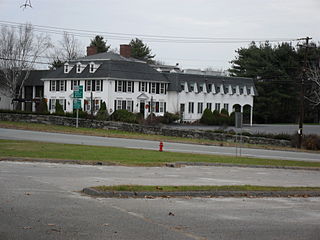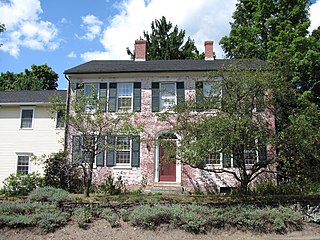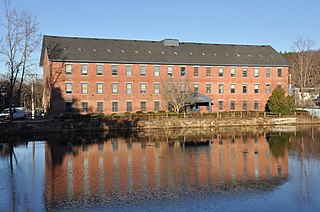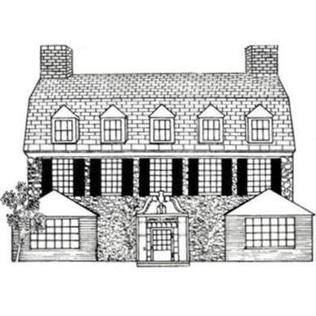
The Emily Dickinson Museum is a historic house museum consisting of two houses: the Dickinson Homestead and the Evergreens. The Dickinson Homestead was the birthplace and home from 1855 to 1886 of 19th-century American poet Emily Dickinson (1830–1886), whose poems were discovered in her bedroom there after her death. The house next door, called the Evergreens, was built by the poet's father, Edward Dickinson, in 1856 as a wedding present for her brother Austin. Located in Amherst, Massachusetts, the houses are preserved as a single museum and are open to the public on guided tours.

The Hon. Bazaleel Taft House is a historic house at 240 South Main Street in Uxbridge, Massachusetts. The oldest portion of this now-large house was built c. 1780-90 by Bazaleel Taft, and is a fine regional example of late Georgian architecture. The house was adapted for use as a restaurant in the 1960s, which has since closed. The house was listed on the National Register of Historic Places in 1983.

The Amherst Central Business District is a historic district encompassing the heart of downtown Amherst, Massachusetts. Centered on the northern section of the long town common, the area has been the civic and commercial heart of the town since the 18th century. The district was listed on the National Register of Historic Places in 1991, and slightly enlarged in 2011.

Amherst West Cemetery is a historic cemetery on Triangle Street in Amherst, Massachusetts. The 4-acre (1.6 ha) cemetery was first laid out in 1730, when the voters of Hadley elected to establish a new burying ground in its eastern precinct. When the area was separated as Amherst in 1786, the property was taken over by the newly established town. In addition to being the burial site of many of Amherst's early settlers and American Civil War veterans, it is also the burial site of members of the Dickinson family, most notably the poet Emily Dickinson. Their family plot is set off from the rest of the cemetery by a wrought iron fence.

The Conkey-Stevens House is a historic brick house located at 664 Main Street in Amherst, Massachusetts. Built in 1840 and remodeled in 1870, it exhibits a well-preserved combination of Greek Revival and Second Empire features. It was listed on the National Register of Historic Places in 1979, and was included as a contributing property to the East Village Historic District in 1986.

The East Village Historic District is a historic district encompassing the center of the East Village of Amherst, Massachusetts, United States. It includes properties on Main Street, North East Street, and South East Street. The village was one of Amherst's principal civic and commercial centers until the arrival of the railroad in Amherst Center in 1853, and remained a primarily residential area thereafter. The district was listed on the National Register of Historic Places in 1986.

The Westside Historic District is a residential historic district that encompasses an early, historically African-American neighborhood in the town of Amherst, Massachusetts. It includes properties on Baker and Snell Streets, Hazel Avenue, and Northampton Road. Most of the properties in the district are houses, many of which were built in a variety of Victorian styles, with houses built later also showing Colonial Revival styling. The oldest houses, on Baker Street, date from 1869 into the 1870s, while those along Route 9 were for the most part built later, and exhibit a wider variety of styles, including some Bungalow/Craftsman houses. The fields that surround the neighborhood and set it off from the surrounding area are also included in the district, which was listed on the National Register of Historic Places in 2000.

The West Hatfield Historic District encompasses the historic rural village center of West Hatfield, Massachusetts. It is centered on the junction of West Street with Linseed Road and Church Avenue, and developed in the 19th century as a railroad-driven agricultural transportation center, populated mainly by immigrants. The district was listed on the National Register of Historic Places in 2005.

The Strong House is a historic house at 67 Amity Street in Amherst, Massachusetts. Built about 1744, it is one of Amherst's oldest surviving houses, and a fine example of mid-18th century Connecticut River Valley architecture. It was given to the Amherst Historical Society in 1916. It currently houses the Amherst History Museum. The house was listed on the National Register of Historic Places in 1984, and included in the Amherst Central Business District in 1991.

The Lincoln–Sunset Historic District is a residential historic district located west of the downtown area of Amherst, Massachusetts. Colloquially known as Millionaire's Row, the district extends along Lincoln and Sunset Avenues between Northampton Street and the campus of the University of Massachusetts, Amherst. This area was one of Amherst's first planned residential subdivisions, and features a large number of high-quality houses, built by merchants, businessmen, and academics. It was added to the National Register of Historic Places in 1993.

The South Amherst Common Historic District encompasses the village common and surrounding buildings of South Amherst, Massachusetts. This area developed as a rural residential village hub in the 18th and 19th centuries. It was listed on the National Register of Historic Places in 1995.

The Ballardvale District in Andover, Massachusetts, encompasses the historic mill village of Ballardvale in the northwestern part of the town. It is centered on the crossing the Shawsheen River by Andover Street, and includes buildings on High Street, Center Street, and other adjacent roads on both sides of the river. The district was listed on the National Register of Historic Places in 1982.

The Central Street District is a historic district encompassing the traditional heart of Andover, Massachusetts prior to the development in the later 19th century of the current town center. It consists mainly of residential and religious properties along Central Street, from Phillips Street in the south to Essex Street in the north. All of the listed properties have frontage on Central Street, even if their addresses are on one of the adjacent streets.

The Kendal Green Historic District is a rural residential district running along North Avenue in Weston, Massachusetts. It extends for about three-quarters of a mile, and includes elements representative of the development of Weston from a rural agricultural community to a residential suburb of Boston. In addition to a variety of predominantly residential and agricultural properties, it includes two formerly industrial sites important in Weston's history: the site of the Hobbs Tannery, and that of the Hook and Hastings Organ Factory. The district was listed on the National Register of Historic Places in 2000.

The Samuel Bancroft House is a historic house in Reading, Massachusetts. With an estimated construction date of 1748, it is one of the town's older surviving houses, and one of a small number from the late colonial period. It was listed on the National Register of Historic Places in 1984.

The Main Street Historic District in Medina, New York, United States, is the downtown commercial core of the village. It is a 12-acre (4.9 ha) area stretching south along Main Street from the Erie Canal to the railroad tracks.

The Hatch Homestead and Mill Historic District encompasses two properties associated with the locally prominent Hatch family on Union Street in Marshfield, Massachusetts. It includes an early Georgian colonial house, and a 19th-century water-powered mill, both located on sites that had seen similar use since the 17th century. The district was listed on the National Register of Historic Places in 2009.

The Jones Library of Amherst, Massachusetts is a public library with three locations, the main building and two branches. The library was established in 1919 by a fund set up in the will of lumberman Samuel Minot Jones. The library is governed by a board of trustees and provides a range of library materials, electronic resources, programming, special collections and events for residents of Amherst and the surrounding area. The library is on the Association of Library Trustees, Advocates, Friends and Foundations’ Literary Landmark Register in recognition of its association with poet Robert Frost.

The Rockwood Road Historic District encompasses a portion of the town center of Norfolk, Massachusetts that has retained significant 19th-century characteristics. It extends along Rockwood Road from the MBTA Commuter Rail line to Boardman Street. This area consists mainly of residential or former residential buildings, as well as the 1863 Norfolk Grange Hall, a former church, and is reflective of the center's growth as a railroad village. The district was added to the National Register of Historic Places in 2017.
























